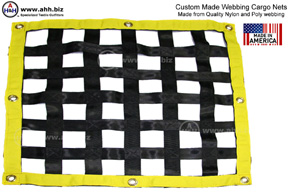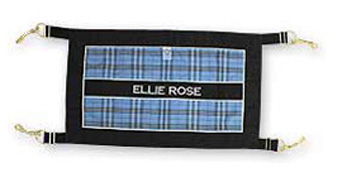How To Make A Sling To
Raise A "Down" Llama
Therapy For the Treatment Of Injury, Heat Stress, or Meningeal Worm
Animals that
are down as a result of Heat Stress or Meningeal Worm need therapy
and exercise on their legs - along with the medications prescribed
by your veterinarian. One way of doing this is to fashion a
sloing and pulley and life the llama periodically each day to
exercise the legs. Do not leave the llama hanging in the sling
for extended periods of time or unattended. Treatment and
therapy for either of the above conditions may possibly take quite a
few weeks before the animal will recover and be able to stand again.
Many animals have recovered after being down for quite awhile -
don't give up on the treatment.
Here are some suggestions from llama owners for rigging
up a reasonably priced sling:
|
"We took a 2x4
and put a large hook and eye through it in the middle of the length
- that went to the pulley. Then we put hooks and eyes going
downwards in three locations along the 2x4 and bought a web horse
stall gate from the feed store. I think the 2x4 is about two
and a half feet long. The straps on the web stall gate already
have hooks on each end. Then we slid the web horse stall gate
under the llama and attached it with chain to the hooks and eyes
we'd put into the 2x4. The chains make the length adjustable.
We later added two fleece lined girths to the back hook so that they
went under her back legs to help hold up her butt. She was
about 250 lbs. and one person could "just" get her up in the air,
tie off the rope, and massage her legs, then lower her into the
kushed position again."
|
"I had an incident that was neccesary to use a sling in
recovery.
In a pinch, the vet and I fashioned one out of a rope hammock. It
already has adjustable holes to secure legs and worked beautifully."
|
"Here are approximate measurements for the sling I had
made for CoCo last year. They used a non-rip, heavy duty tarp material, 5' long,
with
handles (seatbelt webbing) sewn and reinforced on the ends. The width
was about
24" in the middle tapering to the handles to about 8" wide, so it
was shaped somewhat like a diamond. It really worked well and didn't
slide forward
or backward. It supported all of CoCo's weight and we used a
pulley system...cheap at a hardware store!
I never used the horse cinches that came with my chute...they
really
looked like they would pinch and be uncomfortable. And the sling
that did come with it works okay for some things, but when you have an animal
that is really weak and can't hold it's own weight, you need something wide
enough to support it."
|
For the sling, we used
the cargo nets made for the Kawasaki Teryx ATV. We put two
(one would probably work) and folded the edges to size to fit under
the belly of the llama. We then wove a steel T-post through
both edges of the net. We attached chains to the T-posts and
lifted the animal in the sling with the front end loader of the
tractor. A pulley could also be used.
Horse stall guards would
also work as a sling. There are also companies who will make a
woven netting with either webbing material or rope material to your
required size. Hooks can be added. Some suggestions:
|

Custom Made Webbing |

Webbing from www.talcospecialties.com |

Kensington Stall Guard |
|
Also .... U.S. Netting,
www.usnetting.com |
|
 |
 |
 |
| Return To Vet Info |
Return To Heat
Stress |
Return To Shagbark Ridge Llamas |
|
Disclaimer
All information on this website is provided as a public service, but we
cannot guarantee that this information is current or accurate. Readers
should consult with their veterinarian before acting on any treatments.
This document is copyrighted by Shagbark Ridge Llamas and no
part may be copied to another homepage. Permission is granted to link
to this page, copy this document in electronic form, or to print it for
personal use provided that this copyright notice is not altered or removed.
Updated Frequently
© 1996/2018 Shagbark Ridge Llamas

|
|